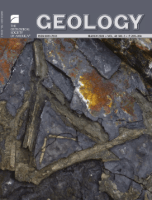
GEOLOGY
Scope & Guideline
Connecting Researchers to the Heart of Earth's Processes
Introduction
Aims and Scopes
- Tectonics and Structural Geology:
Research in this area explores the processes and mechanisms behind tectonic movements, faulting, and the structural evolution of Earth's crust, including studies of fault systems and their implications for seismic activity. - Sedimentology and Stratigraphy:
This scope includes investigations into sedimentary processes, depositional environments, and the stratigraphic record, aiming to understand past climates, sea-level changes, and sediment transport mechanisms. - Geochronology and Geochemistry:
The use of isotopic and elemental analysis to date geological events and understand the chemical evolution of the Earth is a key focus, enabling insights into the timing of tectonic, climatic, and biological changes. - Paleontology and Paleoecology:
Research in this area seeks to uncover the history of life on Earth through the study of fossils, their distributions, and the ecological dynamics that have influenced evolution over geological time. - Volcanology and Petrology:
This area covers the study of volcanic processes, magma generation, and the formation of igneous rocks, focusing on the physical and chemical processes that shape volcanic activity and crustal composition. - Environmental Geology and Geohazards:
Research addressing the interactions between geological processes and human activities, including assessments of geological hazards such as earthquakes, landslides, and volcanic eruptions, as well as the implications of climate change on geological processes.
Trending and Emerging
- Climate Change and Geological Responses:
Research examining the geological impacts of climate change, including sedimentation patterns, erosion rates, and the influence of changing climate on geological hazards, is gaining prominence as awareness of climate issues grows. - Geological Hazards and Risk Assessment:
An increased focus on understanding geological hazards, such as earthquakes and landslides, and their risks to human activities reflects a growing societal need for resilience and preparedness. - Geochemical Cycling and Biogeochemistry:
Emerging studies are increasingly looking at the interactions between biological processes and geological cycles, particularly in relation to carbon cycling and its implications for climate change. - Technological Advancements in Geological Research:
The integration of new technologies such as machine learning, remote sensing, and advanced geochronology techniques is becoming a significant trend, allowing for more detailed and comprehensive geological analysis. - Planetary Geology and Comparative Planetology:
Research exploring geological processes on other planetary bodies, particularly Mars and the Moon, is trending as interest in planetary exploration and understanding extraterrestrial geology increases.
Declining or Waning
- Traditional Mineralogy:
The focus on classical mineralogy studies, which primarily emphasized the identification and classification of minerals, appears to be waning, as the field shifts towards more applied geochemistry and mineral resources. - Static Geological Mapping:
Research centered on static geological maps and basic geological surveys is declining in favor of more dynamic studies that integrate geological mapping with modern techniques such as remote sensing and GIS. - Basic Rock Formation Studies:
There has been a noticeable decrease in publications focusing solely on the formation of specific rock types, as the journal increasingly prioritizes studies that link rock formation to broader geological processes and implications.
Similar Journals
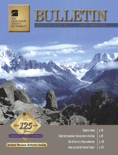
GEOLOGICAL SOCIETY OF AMERICA BULLETIN
Bridging the Past and Future of GeoscienceThe Geological Society of America Bulletin (GSA Bulletin), with ISSN 0016-7606 and E-ISSN 1943-2674, is a premier scholarly journal published by Geological Society of America, Inc. Based in the United States, this journal has been a cornerstone of geological research since its inception in 1890, making significant contributions to the understanding of Earth sciences over more than a century. Recognized for its rigorous peer-review process, the GSA Bulletin currently holds a prestigious Q1 ranking in Geology, positioning it among the top 14 journals in Earth and Planetary Sciences in terms of Scopus ranking, reflecting the high quality and impact of the research it publishes. Researchers, professionals, and students alike benefit from its comprehensive coverage of geological topics, including sedimentology, volcanology, and paleontology, which supports the advancement of knowledge in the geosciences. While the journal is not open access, it continues to provide a vital platform for innovative research and critical discussions that shape the future of geology.

JOURNAL OF GEOLOGY
Innovative Research Shaping Our Understanding of Geology.The JOURNAL OF GEOLOGY, published by University of Chicago Press, serves as a premier platform for disseminating groundbreaking research in the field of geology. Established in 1973, this esteemed journal has consistently ranked in the Q2 category in geology, further solidified by its Scopus ranking, where it is positioned at 99 out of 321 in Earth and Planetary Sciences, marking it in the 69th percentile of its category. With an emphasis on innovative and interdisciplinary studies, the journal features peer-reviewed articles that contribute to the understanding of geological processes, earth materials, and environmental interactions. Although it does not currently offer open access, it facilitates broad access through academic institutions to reach a global audience of researchers, professionals, and students striving to advance the knowledge of Earth's history and dynamics. As a vital resource for the geology community, the JOURNAL OF GEOLOGY plays an essential role in fostering scholarly dialogue and advancing both academic inquiry and practical applications in geology.
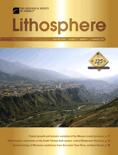
Lithosphere
Unveiling the Mysteries of Our Planet's Lithosphere.Lithosphere, published by GEOSCIENCEWORLD, is a premier open access journal that has been at the forefront of geological research since its inception. With the ISSN 1941-8264 and the E-ISSN 1947-4253, this journal serves as a vital resource for researchers, professionals, and students interested in Earth and planetary sciences, particularly in the field of geology. Its impressive ranking of Q2 in the 2023 category indicates its vital role in disseminating high-quality, impactful research. The journal’s commitment to open access since 2018 enhances its reach, providing global accessibility to cutting-edge studies that span a diverse range of geoscientific topics, from tectonics to sedimentology. With Scopus Rank #88 out of 321 in Earth and Planetary Sciences, it offers a strong platform for scholars to share their findings and engage with the latest advancements in the discipline. As the journal continues its convergence from 2009 to 2024, Lithosphere remains a crucial publication for those striving to deepen their understanding of Earth's systems.

ANNALES SOCIETATIS GEOLOGORUM POLONIAE
Connecting Researchers to the Heart of Geological Science.ANNALES SOCIETATIS GEOLOGORUM POLONIAE is a distinguished journal published by the Polish Geological Society, focusing on pivotal research in the fields of geology, economic geology, and stratigraphy. With an ISSN of 0208-9068, this journal has established itself as an essential platform for disseminating significant findings and advancements in geological sciences since its convergence in 2008. The journal proudly holds a Q2 quartile ranking in the categories of Economic Geology, Geology, and Stratigraphy as of 2023, indicating its respectable position within the global academic community. Researchers will find its indexed status in Scopus, ranking #138/321 in Geology and showcasing a solid presence in key geological sub-disciplines. While the journal is not open access, it remains a vital resource for professionals and students striving for insight into contemporary geological research. Located in Krakow, Poland, the journal continues to contribute significantly to the understanding of geological processes and resources, making it an indispensable reference for anyone in the field.

Turkiye Jeoloji Bulteni-Geological Bulletin of Turkey
Uncovering the mysteries of the earth, one study at a time.Turkiye Jeoloji Bulteni-Geological Bulletin of Turkey (ISSN: 1016-9164) is a prominent scholarly journal published by the TMMOB JEOLOJI MUHENDISLERI ODASI in Türkiye, dedicated to advancing the field of geology through high-quality research and dissemination of significant scientific findings. With an emphasis on geological studies pertinent to the region and its global implications, the journal serves as a crucial platform for researchers, professionals, and students aiming to share and explore innovative theories, methodologies, and case studies. Although the journal operates under a traditional access model, its rich content provides valuable insights into varied topics including but not limited to mineralogy, geophysics, petrology, and environmental geology. Furthermore, the journal's commitment to exhibiting originality and relevance ensures its vital role in shaping geological research, fostering collaboration among academics and practitioners alike.
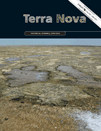
TERRA NOVA
Exploring the Depths of Geological InnovationTERRA NOVA, published by WILEY, is a leading journal in the field of Geology, with a remarkable impact within the academic community. With the ISSN 0954-4879 and E-ISSN 1365-3121, the journal has been a pivotal platform for innovative research since its inception in 1989 and will continue its influence through to 2024. Ranked in the top tier (Q1) of its category for 2023, TERRA NOVA holds an esteemed position with a Scopus ranking of 67 out of 321 in Earth and Planetary Sciences, showcasing its dedication to high-quality, impactful scientific discourse. The journal covers a diverse range of topics within geology, providing valuable insights for environmental scientists, geologists, and industry professionals. By fostering an interdisciplinary approach, TERRA NOVA remains committed to advancing the understanding of geological processes and their implications for society. With a dedicated readership of researchers, professionals, and students, this journal is essential for those looking to stay abreast of the latest developments and trends in the field.

INTERNATIONAL GEOLOGY REVIEW
Pioneering insights into the dynamic world of geology.INTERNATIONAL GEOLOGY REVIEW, published by Taylor & Francis Inc, is a premier journal dedicated to advancing the field of geology since its inception in 1959. With its Q1 ranking in the field of Geology for 2023, this journal is a significant platform for researchers, professionals, and students exploring the intricacies of Earth and planetary sciences. The journal has been rated in the 81st percentile within Scopus rankings, reflecting its influence and the high quality of articles published. Although it does not offer Open Access options, the journal maintains a rigorous peer-review process to ensure the publication of original and impactful research. With an extensive archive projected to continue until 2024, INTERNATIONAL GEOLOGY REVIEW serves as an essential resource for those seeking to deepen their understanding of geological phenomena, making it a vital contributor to the global scientific community.

BULLETIN OF GEOSCIENCES
Exploring the Dynamics of Our Planet, One Study at a TimeBULLETIN OF GEOSCIENCES, published by the prestigious Czech Geological Survey, stands as a pivotal resource in the fields of Earth and Planetary Sciences and Environmental Science. Since its inception in 2003, the journal has been committed to advancing knowledge through high-quality research, currently holding a commendable Q2 ranking in both disciplines. With its focus on diverse and innovative topics, BULLETIN OF GEOSCIENCES provides an essential platform for researchers, professionals, and students aiming to disseminate and access impactful studies. The journal is indexed in Scopus, ranking #78/195 in General Earth and Planetary Sciences and #110/233 in General Environmental Science, reflecting its significant contribution to academia. Publishing from Prague, Czech Republic, this journal invites contributions that illuminate the interactions between geological processes and environmental phenomena, ensuring an inclusive and accessible approach to crucial global issues.

Swiss Journal of Geosciences
Bridging Knowledge Gaps in Earth and Planetary SciencesSwiss Journal of Geosciences is a prestigious academic journal dedicated to advancing the field of geosciences, published by SPRINGER INTERNATIONAL PUBLISHING AG. Since its inception in 2007, the journal has established itself as a leading platform for disseminating high-quality research findings in various domains related to Earth and planetary sciences, achieving a notable Q1 ranking in Geology as of 2023. With a solid reputation reflected in its Scopus ranking of Rank #72/321, the journal stands in the 77th percentile within its category. Based in Switzerland, the Swiss Journal of Geosciences embraces an open access model, making it easier for researchers, professionals, and students worldwide to access vital geological research without barriers. The journal’s objectives include promoting interdisciplinary research and fostering insights that address both fundamental and applied geoscientific problems, ensuring it remains a crucial resource for those seeking to understand our planet’s dynamics. Engage with pioneering research and contribute to the vibrant community of geoscientists by exploring the impactful articles published within its pages.
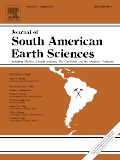
JOURNAL OF SOUTH AMERICAN EARTH SCIENCES
Fostering Insights into Earth's Dynamic ProcessesJOURNAL OF SOUTH AMERICAN EARTH SCIENCES is a premier interdisciplinary journal dedicated to publishing high-quality research in the fields of Earth-Surface Processes, Geology, and Paleontology, making it an essential resource for scientists and researchers focused on South American geology and its diverse geological phenomena. Published by Pergamon-Elsevier Science Ltd in the United Kingdom, this journal has been instrumental in disseminating groundbreaking studies since 1988, showcasing contributions that push the boundaries of knowledge in Earth and Planetary Sciences. With an impressive Scopus ranking—positioning it in the 74th percentile for Paleontology and 71st for Geology—this journal not only reflects robust academic quality but also its commitment to addressing critical geological challenges in South America. Researchers will appreciate its objective of advancing understanding of geological processes while providing insights into past, present, and future Earth environments. Although available through traditional subscription models, the journal's vast repository of articles enriches the academic landscape, facilitating the sharing of vital research among professionals, students, and geological practitioners.